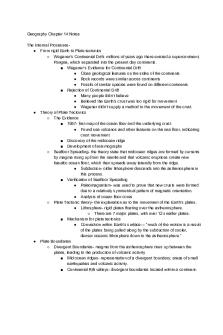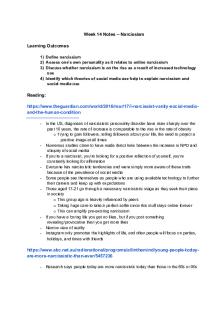Chapter 14 - class notes PDF

| Title | Chapter 14 - class notes |
|---|---|
| Course | Introduction To Health And Wellness |
| Institution | Kutztown University of Pennsylvania |
| Pages | 4 |
| File Size | 83.8 KB |
| File Type | |
| Total Downloads | 61 |
| Total Views | 185 |
Summary
class notes...
Description
1. The collective term for various diseases of the heart and blood vessels is ______ disease. a. Cardiovascular 2. The ______ system consists of the heart and blood vessels, which together move blood throughout the body. a. Cardiovascular 3. The left side of the heart pumps oxygen-rich blood throughout the body in a process called ______ circulation. a. Systemic 4. The inferior and superior vena cava carry a. oxygen-poor blood from the body into the right atrium of heart. 5. What is the largest artery in the body? a. The aorta 6. Cardiovascular disease is the leading cause of death for ______ in the United States. a. Both men and women 7. True or false: As blood is pumped through the chambers of the heart it directly supplies the heart with oxygen and nutrients. a. False 8. Which of the following are types of blood vessels? a. arteries b. veins c. Capillaries 9. What is the process by which arteries become hard and thickened due to buildup of cholesterol and other substances on their walls? a. Atherosclerosis 10. The right side of the heart pumps oxygen-poor blood to the lungs in a process called ______ circulation. a. Pulmonary 11. The substances that carry fats through the bloodstream are called a. Lipoproteins. 12. The veins that return deoxygenated blood to the heart are the superior and inferior a. Vena; cava 13. The aorta connects with which chamber of the heart? a. the left ventricle 14. The material that accumulates on the artery wall and causes damage and calcification is called _______ (Remember to type only one word in the blank.) a. Plaque 15. The arteries that supply blood to the heart muscle itself are called the ____ arteries. a. Coronary 16. What is the process by which arteries become hard and stiff as a result of too much pressure?
a. Atherosclerosis 17. How does an aneurysm pose a risk to health? a. It can rupture, leading to a severe loss of blood. 18. The waxy, fatty substance that is necessary in small amounts in the body but can be dangerous at high levels is called a. Cholesterol 19. The buildup of material on the walls of arteries can cause which of the following? a. The speed and amount of blood flow are lessened. b. Chunks of this material can break off and block the artery. 20. What is the name for a weakened and stretched part of an artery wall? a. Aneurysm 21. Coronary heart disease is sometimes called coronary ______ disease. a. Artery 22. The condition in which the heart muscle does not g et enough oxygen-rich blood because of a narrowing or blocking of the coronary artery is called a. Ischemia. 23. Which of the following occurs when a coronary artery becomes completely blocked, preventing the heart from getting enough blood? a. myocardial infarction 24. Classic heart attack symptoms are less likely to appear in a. Women 25. Pain, heaviness, or tightness in the chest, and often in the arm or shoulder, caused by the heart muscle not receiving enough blood is called a. Angina 26. Coronary artery disease is caused by atherosclerosis in the arteries that supply blood to the a. Heart 27. A change in the normal pattern of the heartbeat is called a. Arrythmia 28. What causes coronary ischemia? a. a narrowing of the coronary arteries 29. Ventricular fibrillation is a type of arrhythmia that results in a. Sudden cardiac death 30. What is the term for a blood clot that blocks an artery, which can lead to a heart attack? a. coronary thrombosis 31. Signs of a heart attack may include discomfort in which of the following? a. Chest, jaw 32. Ventricular fibrillation can be stopped by using a(n) ______ _______ defibrillator a. Automated, external
33. True or false: Strokes are the leading cause of severe, long-term disability in the United States. a. False 34. What is the type of stroke that occurs when an artery in the brain becomes blocked? a. Ischemic 35. What is the arrhythmia that causes the heart to quiver rather than beat? a. ventricular fibrillation 36. Blocked blood flow to the brain results in a stroke, or a. cerebrovascular accident. 37. Which type of stroke accounts for 87% of all strokes? a. Ischemic 38. The rupture of a blood vessel within the brain is called a(n) a. intracerebral hemorrhage. 39. Which of the following statements are true about an embolism? a. It travels from one part of the body to another. 40. A subarachnoid hemorrhage is a blood vessel rupture that is located on the brain's surface and blood accumulates between the a. brain and skull. 41. Transient ischemic attacks result in a. little to no tissue death. 42. A blood clot that develops in a narrowed artery is called a(n) a. Thrombus 43. True or false: Strokes are the leading cause of severe, long-term disability in the United States. a. False 44. True or false: An intracerebral hemorrhage results from the rupture of an artery within the brain. a. True 45. During congestive heart failure, blood backs up in the a. Lungs 46. Which of the following is sometimes called a "ministroke"? a. transient ischemic attacks 47. Which of the following can occur when heart valves do not function normally? a. Blood can leak backward between heart chambers. b. Blood does not flow through the heart smoothly. 48. Blocked blood flow to the brain results in a stroke, or a. cerebrovascular accident. 49. Atherosclerosis in the arms or legs results in a. peripheral vascular disease. 50. Why is peripheral vascular disease in the legs a major cause of disability in older people?
a. It produces pain during walking. 51. Cigarette smokers' risk of heart disease is how much greater than that of nonsmokers? a. two to four times 52. What are ways in which smoking can affect cardiovascular health? a. Smoking can lead to blood clots in the coronary arteries. 53. Exercise increases the level of ______ (good cholesterol) in the body. a. HDL 54. Which of the following statements concerning racial factors for cardiovascular disease (CVD) risk are true? a. Factors other than genetics may play a role in the rates of CVD in different racial groups. b. Mexican Americans have a higher risk of CVD than Whites. c. The death rate from heart attack has declined less among minority groups and women. 55. When the heart contracts, the ______ blood pressure is measured. a. Systolic 56. Which of the following statements regarding hypertension is true? a. Nearly one in three adults in the United States has hypertension. 57. Which of the following are causes of high blood pressure? a. low potassium levels b. genetics c. Obesity 58. When the heart relaxes between contractions, the ______ blood pressure is measured. a. Diastolic 59. Hypertension increases the risk of which of the following? a. heart attack b. kidney disease c. Stroke 60. Which of the following statements regarding hypertension is true? a. Nearly one in three adults in the United States has hypertension. 61. Which of the following statements about HDL levels is true? a. They are influenced by exercise. 62. Studies have shown which of the following relationships between alcoholic intake and cardiovascular disease (CVD)? a. A man who has a single drink a day may gain a protective effect against CVD. b. A woman who drinks but less than one full drink a day may gain a protective effect against CVD. c. A man who has more than two drinks a day increases his risk of CVD. 63....
Similar Free PDFs

Chapter 14 - class notes
- 4 Pages

Chapter 14 class notes
- 15 Pages

Class 14 - Lecture notes 2
- 1 Pages

Chapter 14 - Lecture notes 14
- 5 Pages

Chapter 1 - class notes
- 7 Pages

Chapter 8 - class notes
- 4 Pages

Chapter 7 - Class notes
- 7 Pages

Chapter 9 - class notes
- 7 Pages

Chapter 6 - class notes
- 4 Pages

Chapter 1 - class notes
- 4 Pages

Chapter 4 - class notes
- 7 Pages

Chapter 15 - class notes
- 8 Pages

Geography Chapter 14 Notes
- 5 Pages

Chapter 8 CLass Notes
- 13 Pages

Chapter 1 - class notes
- 7 Pages
Popular Institutions
- Tinajero National High School - Annex
- Politeknik Caltex Riau
- Yokohama City University
- SGT University
- University of Al-Qadisiyah
- Divine Word College of Vigan
- Techniek College Rotterdam
- Universidade de Santiago
- Universiti Teknologi MARA Cawangan Johor Kampus Pasir Gudang
- Poltekkes Kemenkes Yogyakarta
- Baguio City National High School
- Colegio san marcos
- preparatoria uno
- Centro de Bachillerato Tecnológico Industrial y de Servicios No. 107
- Dalian Maritime University
- Quang Trung Secondary School
- Colegio Tecnológico en Informática
- Corporación Regional de Educación Superior
- Grupo CEDVA
- Dar Al Uloom University
- Centro de Estudios Preuniversitarios de la Universidad Nacional de Ingeniería
- 上智大学
- Aakash International School, Nuna Majara
- San Felipe Neri Catholic School
- Kang Chiao International School - New Taipei City
- Misamis Occidental National High School
- Institución Educativa Escuela Normal Juan Ladrilleros
- Kolehiyo ng Pantukan
- Batanes State College
- Instituto Continental
- Sekolah Menengah Kejuruan Kesehatan Kaltara (Tarakan)
- Colegio de La Inmaculada Concepcion - Cebu
